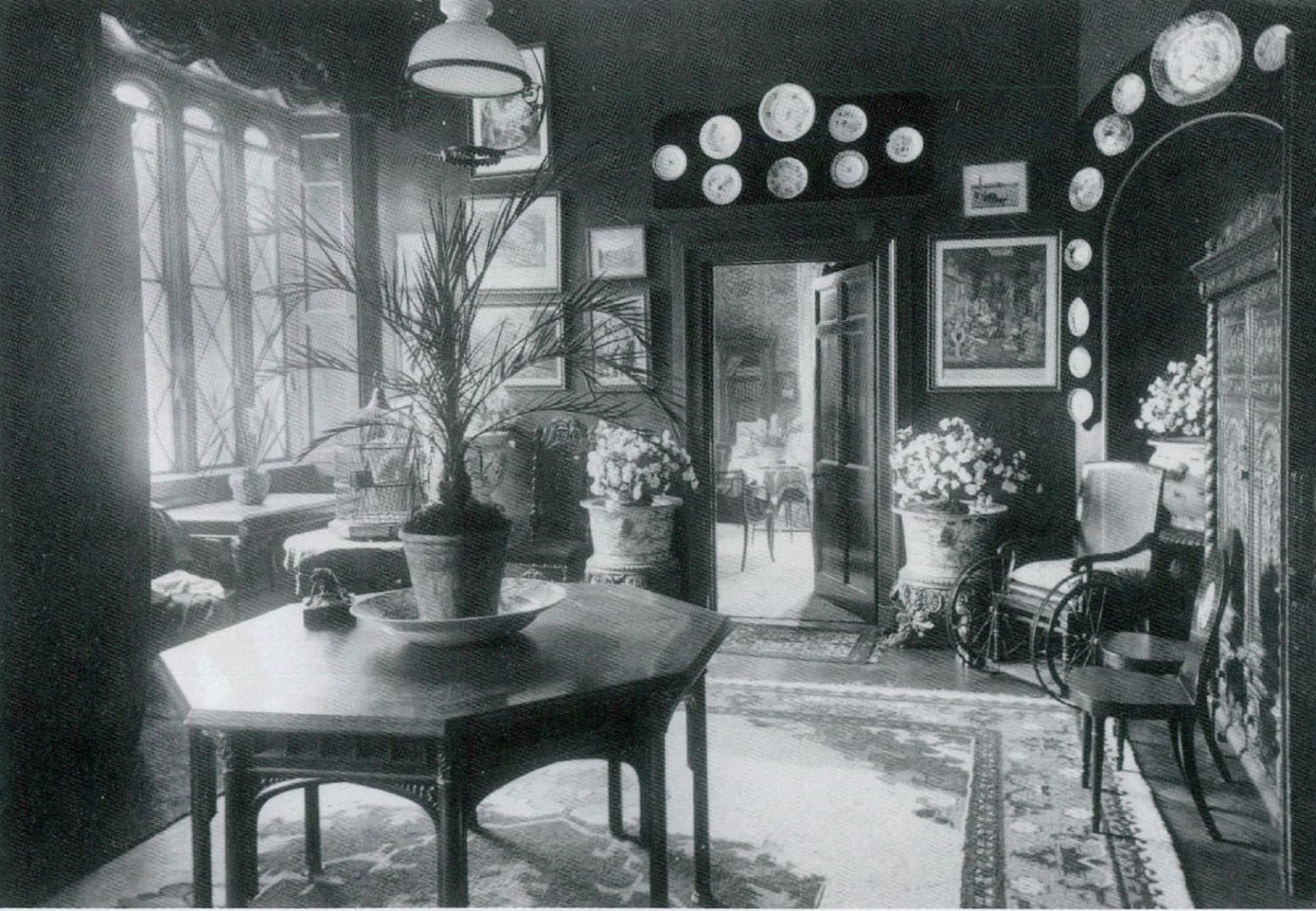Tables
The Bridehead Library Table: A William IV Gothic revival Oak Library table
Width: 53.15” 135 cm
Further images
Provenance
Bridehead, Robert Williams II ( 1767-1847)
Literature
A. W. N. Pugin, Contrasts (1836) and The True Principles of Pointed Architecture (1841).
Richard Hicks Bridgens, Furniture with Candelabra and Interior Decoration (London, 1838)
Clive Wainwright, The Romantic Interior: The British Collector at Home, 1750–1850 (1989
Geoffrey Beard & Judith Goodison, English Furniture 1500–1840 (1987)
John Kenworthy-Browne et al., The Gothic Revival (V&A exhibition catalogue, 1981)
The Bridehead Library Table: A William IV Gothic revival Oak Library table. English, circa 1830
Description and design
A William IV oak table of bold octagonal form, the top inset with the original tooled leather framed by a wide crossbanded border; above a frieze incorporating molded drawers, each divided by stop-fluted uprights. The table stands on eight turned legs surmounted by finely carved foliate capitals, with spandrels formed as flattened Gothic arches enriched with trailing foliage and fruit. The overall design unites structural clarity with the picturesque ornament characteristic of the early Gothic Revival.
The vast majority of octagonal library tables of this period are supported on a single pedestal base, this example employs a full octet of legs. This very rare structural decision reflects a conscious architectural design choice, treating the table as a miniature Gothic edifice. Such ingenuity is entirely consistent with Bridehead’s approach to its furnishings, which was conceived in close reference to the architecture of the house itself.
Bridehead and the Gothic Revival
This table formed part of the library furnishings at Bridehead, Dorset, during its 19th-century remodeling. The estate was transformed under the ownership of Robert Williams (1735–1814) and his son Robert Williams II (1767–1847), and became a showcase of the Gothic Revival, with architecture by Peter Frederick Robinson and later Benjamin Ferrey. Ferrey, a student and close friend of A.W.N. Pugin, was among the foremost advocates of the Gothic style in the early Victorian period. Pugin himself had argued that the Gothic library was the most fitting environment for study and reflection, a view that Ferrey carried into his architectural and decorative work at Bridehead.
Ferrey’s Role in the Furnishings
While Ferrey was not a furniture designer by profession, his role as architect of Bridehead’s Gothic interiors almost certainly extended to the conception of the library furnishings. An earlier Sotheby’s valuation attributed the suite to his direction, and it is plausible that he oversaw the commissioning of this table to ensure stylistic harmony between architecture and furniture.
The Bullock and Bridgens Connection
The Williams family’s earlier connection with George Bullock is particularly significant. Robert Williams II’s Hertfordshire estate, Moor Park, was furnished with examples from Bullock’s workshop, establishing a direct relationship between the family and one of the foremost designers of the Regency period. When Williams later retired to Dorset to remodel Bridehead, it is likely that he turned again to the same design circle. By this time Richard Bridgens, Bullock’s collaborator and later the author of Furniture with Candelabra and Interior Decoration (1838), was active in producing furniture of precisely this character.
The table’s unusual eight-legged structure, carved foliate capitals, and Gothic spandrels align closely with Bridgens’s published vocabulary and echo the “ponderous and fantastic” qualities for which his work was praised by Virginia Glenn. Taken together, the evidence suggests that the Bridehead library suite was conceived under Ferrey’s architectural oversight but executed by one of the leading Gothic Revival workshops of the period, most probably in the Bridgens–Bullock circle, with whom the Williams family already had demonstrable ties.
The Williams Family
The family’s background and interests help to explain the quality and ambition of Bridehead’s furnishings. Robert Williams I descended from an established Dorset family, and trained as a cabinetmaker in Covent Garden before becoming a shipbuilder for the East India Company, eventually owning fourteen ships and serving as a Director. He later became a banker and MP for Dorchester, amassing a fortune of over half a million pounds at his death in 1814.
His son, Robert II, continued this legacy of wealth and discernment, acquiring Moor Park in Hertfordshire, where the family is recorded as commissioning furniture by leading makers including George Bullock. This association placed the Williams family in direct contact with the foremost designers of the Regency and early Gothic Revival periods, providing the foundations for the ambitious programme of furnishing later undertaken at Bridehead.
The Gothic Revival in Furniture and Architecture
The Gothic Revival was one of the most influential design movements of the 19th century, reshaping both architecture and the decorative arts. Rooted in British romanticism and antiquarianism, it gained momentum in the early 19th century, nourished by the rediscovery of medieval forms and championed by designers such as A. C. Pugin and George Smith.
Furniture makers responded to this revival with bold designs in oak, incorporating Gothic tracery, pointed arches, and foliate carving. George Smith’s Household Furniture (1826) argued that the Gothic style was especially suited to the library, a sentiment echoed in the conception of the Bridehead suite.
At the same time, the Gothic Revival reshaped Britain’s built environment. From Horace Walpole’s Strawberry Hill (1749–77) to A.W.N. Pugin’s collaboration with Charles Barry at the Palace of Westminster (from 1837), Gothic became associated with morality, faith, and national identity. By the 1830s–40s, it was the dominant style for churches, universities, civic buildings, and elite country houses—including Bridehead.
From Britain the Gothic Revival quickly spread across the Atlantic, where architects such as Richard Upjohn and A. J. Davis popularised the style for American churches and villas. Cabinetmakers in New York, Boston, and Philadelphia produced eclectic Gothic furniture that blended medieval motifs with contemporary taste. Prestigious commissions, such as the Deming House Gothic Library Table (Metropolitan Museum of Art), show how British models—like the Bridehead table—directly inspired America’s cultural elite.
Summery
This table is a rare survival from the early 19th-century Gothic Revival, created for a house that epitomised the movement and its pursuit of harmony between architecture and interior design.





